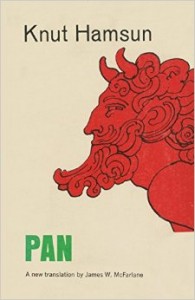
March 1970. I’m living in Berkeley, my impersonation of a graduate student in history falling apart. I decide to go to sea. It worked for Melville, for Richard Henry Dana, for Jack London … I get a berth on a ship out of Oakland, and in the two weeks before we sail I go the rounds of my scruffy friends, hinting at dangers to come for the daring young adventurer.
A guy in a bookstore in Palo Alto recommends some books to take along. One is Pan, by the Norwegian Knut Hamsun (1859–1952), someone heretofore unknown to me. A few weeks later, at sea, standing uncertainly on quivering legs, with many hours of little or nothing to do aboard—the steward had warned me to stay out of sight when not with a mop in my hands, and to work slower, by God, on this unionized ship—I find the paperback at the bottom of my duffel. A young adventurer, Lt. Thomas Glahn, is living alone in a forest hut on a wilderness island. The madly bursting, insanely concentrated Arctic summer is upon him, and he fishes and hunts, reading meanings in the markings on the powdery wings of giant moths that come out in the undark nights. Nature apprehended with a full if unstable sensorium: this is the first shock of Pan, Glahn’s tender, ecstatic, yet often amused response to the natural world. The second shock is how out of control, sexually out of control, are these 19th-century Norwegian Lutherans. The handsome lieutenant is ever on the hunt for females, and they find him: the island’s small harbor-town is full of maidens, who respond to him as if to some night-flower exuding delicious nectar.
I had never read Rousseau (and still haven’t read more than bits). Thus it went right over my head that Hamsun was writing an anti-Rousseauvian story, to confront the proposition that people in a state of nature live more honorably, more simply, more authentically. Hamsun, a largely self-schooled wanderer upon many rough roads, who visited America twice in the 1880s (deciding that we were a failure as a culture and a country), laughs in the teeth of this idea. Lt. Glahn’s erratic will and whimsical cruelties are mirrored by the impulsivities of Edvarda, a village girl in tight, high-collared Edwardian blouse and long dark skirt, with witchy little boots on her flirty feet. To say these two lovers ruin each other is only to begin to sum up the harm they do.
Romantic love! Love among the birches, eros on the forest floor! Although the outcomes for the characters are tragic, the novel presents such a juicy, throbbing world of sensation and glamorous heartbreak that a fool of 23 can be forgiven, possibly, for getting some wrong messages. At the end of my seafaring, I went straight to the Santa Cruz Mountains to live for the next 12 years in a house in a forest, with other back-to-the-land dreamers and schemers. There we cultivated our own intensities under the sign of Pan, pretending, since it was more fun to pretend, that we were walking a new road.


